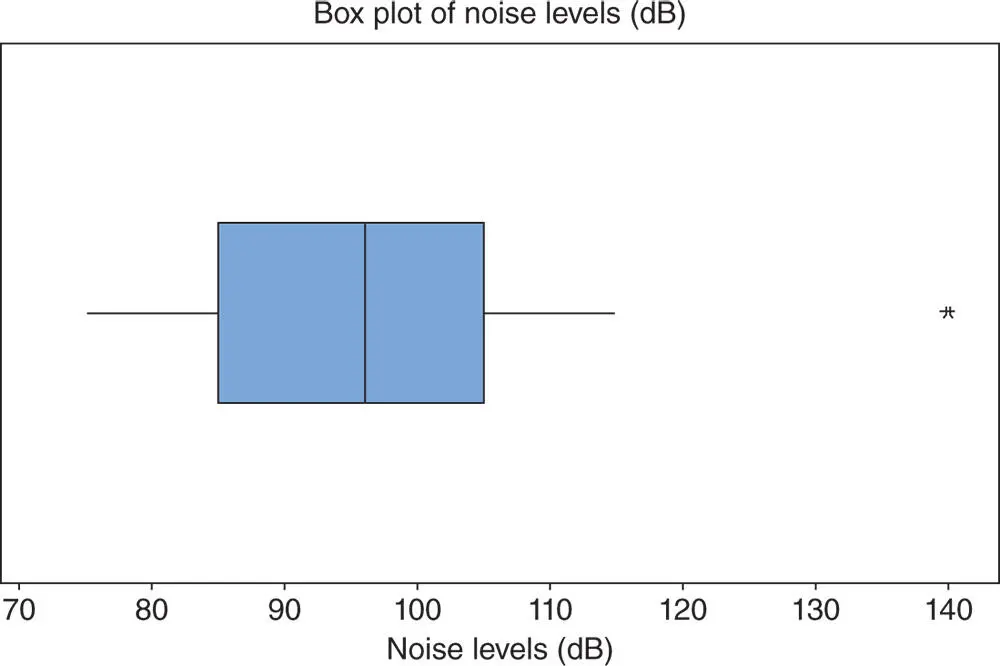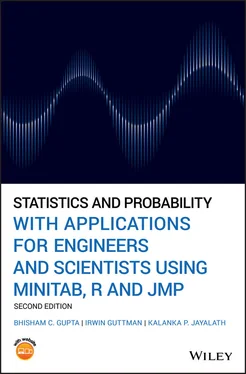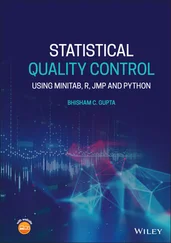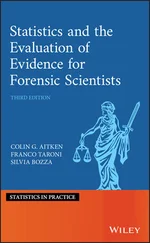3 Step 3. From the outer lines, draw straight lines extending outwardly up to three times the IQR and mark them as shown in Figure 2.8.1. Note that each distance between the points A and B, B and C, D and E, and E and F is equal to one and a one‐half times distance between the points C and D, or one and one‐half times IQR. The points S and L are, respectively, the smallest and largest data points that fall within the inner fences. The lines from S to C and D to L are called the whiskers.
2.8.2 How to Use the Box Plot
About the Outliers
1 Any data points that fall beyond the lower and upper outer fences are the extreme outliers. These points are usually excluded from the analysis.
2 Any data points between the inner and outer fences are the mild outliers. These points are excluded from the analysis only if we were convinced that these points are somehow recorded or measured in error.
About the Shape of the Distribution
1 If the second quartile (median) is close to the center of the box and each of the whiskers is approximately of equal length, then the distribution is symmetric.
2 If the right box is substantially larger than the left box and/or the right whisker is much longer than the left whisker, then the distribution is right‐skewed.
3 If the left box is substantially larger than the right box and/or the left whisker is much longer than the right whisker, then the distribution is left‐skewed.
Example 2.8.1(Noise levels) The following data gives the noise level measured in decibels (a usual conversation by humans produces a noise level of about 75 dB) produced by 15 different machines in a very large manufacturing plant:
85 80 88 95 115 110 105 104 89 87 96 140 75 79 99
Construct a box plot and examine whether the data set contains any outliers.

Figure 2.8.2Box plot for the data in Example 2.8.1.
Solution:First we arrange the data in the ascending order and rank them.
| Data values |
75 |
79 |
80 |
85 |
88 |
89 |
95 |
96 |
97 |
99 |
104 |
105 |
110 |
115 |
140 |
| Ranks |
1 |
2 |
3 |
4 |
5 |
6 |
7 |
8 |
9 |
10 |
11 |
12 |
13 |
14 |
15 |
We then find the ranks of the quartiles  ,
,  , and
, and  . Thus, we have (
. Thus, we have (  )
)
Rank of  = (25/100)(15+1) = 4
= (25/100)(15+1) = 4
Rank of  = (50/100)(15+1) = 8
= (50/100)(15+1) = 8
Rank of  = (75/100)(15+1) = 12
= (75/100)(15+1) = 12
Therefore, the values of  ,
,  , and
, and  are 85, 96, and 105, respectively, and the interquartile range is
are 85, 96, and 105, respectively, and the interquartile range is


Figure 2.8.2shows the box plot for these data. Figure 2.8.2shows that the data include one outlier. In this case, action should be taken to modify the machine that produced a noise level of 140 dB. Use MINITAB to create a box plot:
1 Enter the data in column C1.
2 From the Menu bar, select Graph Boxplot. This prompts a dialog box to appear. In this dialog box, select simple and click OK. This prompts another dialog box to appear.
3 In this dialog box, enter C1 in the box under the Graph variables and click OK. Then, the box plot shown in Figure 2.8.3will appear in the Session window.

Figure 2.8.3MNITAB printout of box plot for the data in Example 2.8.1.
USING R
We can use a built in ‘boxplot()’ function in R to generate box plots. Extra arguments such as inserting a heading, labeling  ‐axis, and coloring can be done as shown in the following R code.
‐axis, and coloring can be done as shown in the following R code.
NoiseLevels = c(75,79,80,85,88,89,95,96,97,99,104,105,110,115,140) #To plot boxplot boxplot(NoiseLevels, main = ‘Box plot of Noise Levels (dB)’, ylab = ‘Noise Levels (dB)’, col = ‘grey’)
Example 2.8.2(Bus riders') From the bus riders' data in Example 2.7.4, we have
| 12 |
12 |
14 |
15 |
16 |
16 |
16 |
16 |
17 |
17 |
17 |
18 |
18 |
18 |
19 |
19 |
20 |
20 |
20 |
20 |
| 20 |
20 |
20 |
20 |
21 |
21 |
21 |
22 |
22 |
23 |
23 |
23 |
24 |
24 |
25 |
26 |
26 |
28 |
28 |
28 |
1 Find the mean, mode, and median for these data.
2 Prepare the box plot for the data.
3 Using the results of parts (a) and (b), verify if the data are symmetric or skewed. Examine whether the conclusions made using the two methods, the results of part (a) and (b) about the shapes of the distribution, are the same or not.
4 Using the box plot, check if the data contain any outliers.
5 If in part (c) the conclusion is that the data are symmetric, then find the standard deviation and verify if the empirical rule holds or not.
Solution:The sample size in this problem is n = 40. Thus, we have
1 Mean , mode , and median
2 To prepare the box plot, we first find the quartiles , , and .Rank of Rank of Rank of .Since the data presented in this problem are already in the ascending order, we can easily see that the quartiles , , and areThe interquartile range is IQR . Thus, Figure 2.8.4Box plot for the data in Example 2.8.2.The box plot for the data is as shown in Figure 2.8.4.
3 Both parts (a) and (b) lead to the same conclusion; that is, the data are symmetric.
Читать дальше


 ,
,  , and
, and  . Thus, we have (
. Thus, we have (  )
) = (25/100)(15+1) = 4
= (25/100)(15+1) = 4 = (50/100)(15+1) = 8
= (50/100)(15+1) = 8 = (75/100)(15+1) = 12
= (75/100)(15+1) = 12 ,
,  , and
, and  are 85, 96, and 105, respectively, and the interquartile range is
are 85, 96, and 105, respectively, and the interquartile range is


 ‐axis, and coloring can be done as shown in the following R code.
‐axis, and coloring can be done as shown in the following R code.










